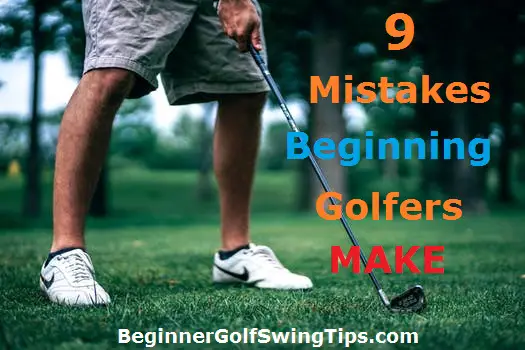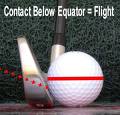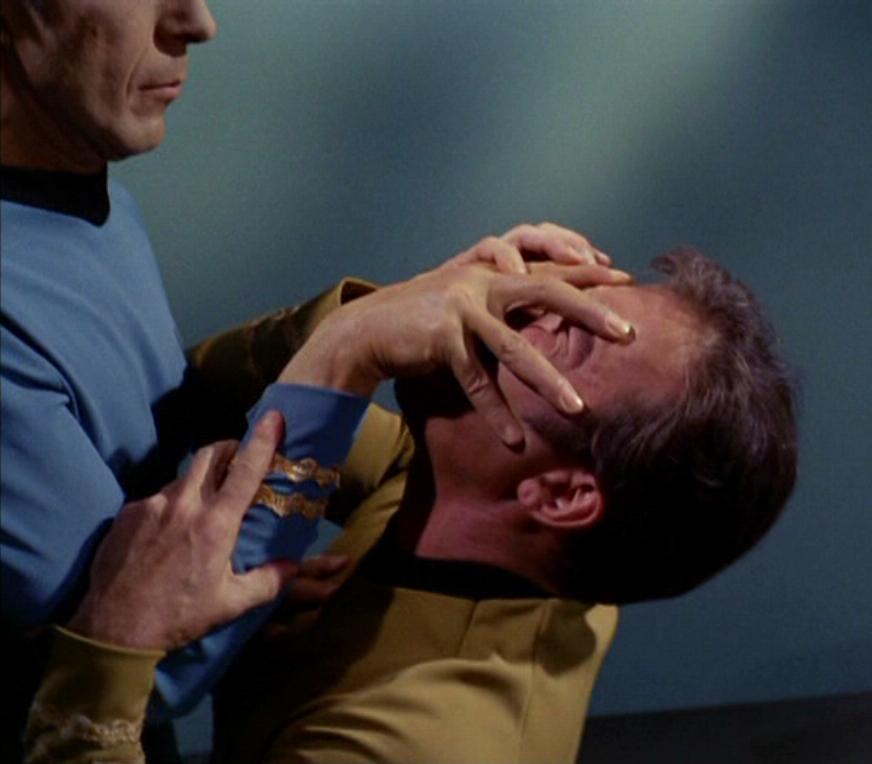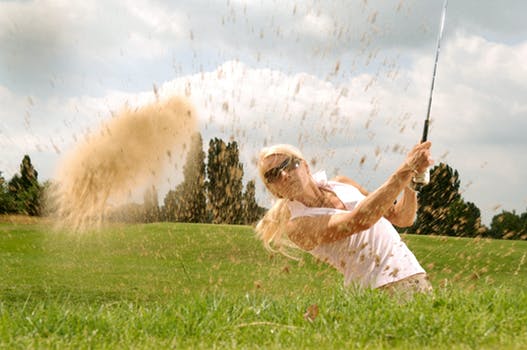Mistakes Every Beginning Golfer Makes (And How to Fix Them)
 Here I want to talk about 9 Mistakes Every Beginning Golfer Makes (And How to Fix Them).
Here I want to talk about 9 Mistakes Every Beginning Golfer Makes (And How to Fix Them).
Unfortunately, all golfers make mistakes.
Even PGA Tour Pros.
However, beginner golfers tend to repeat the same mistakes over and over again.
After teaching golf for over a decade, I noticed that I kept seeing the same mistakes among my students.
What did they have in common?
They were all beginners.
As I identified what these common golf mistakes were, I also tried to develop a plan to help correct each and every one.
In today’s lesson, I am going to review the most common mistakes every beginning golfer makes (I observed among my student golfers) and discuss HOW to fix each mistake one at a time.
Mistake #1 – Not Keeping Your Head Down
Okay – we’ll start with a piece of golf advice that’s probably as old as golf itself: Keep Your Head Down!
Not keeping your head down through your golf swing is a mistake that many beginning golfers make. It’s also one that you may have heard of before.
But today let’s look at WHY this is a problem and what we can do to fix it.
Keeping your head down through your golf swing enables you to keep your eye on the ball (target). Remember – you are trying to hit a pretty small object with a (relatively) small part of the golf club (the face).
So keeping your eye on the ball is definitely a GOOD thing.
But – even more importantly – when you keep your head down it PREVENTS your lead shoulder from coming UP!
When you lift your head during your swing, your body naturally raises your lead shoulder (this is the left shoulder for right-handed golfers) first and then your head follows. Your body does this because your shoulder is used to help lift your head.
The problem with this is that when your left shoulder comes up the golf club comes up too. You start to come out of your golf stance.
The club will strike the golf ball closer to the sole of the club – as opposed to the sweet spot – and the result is a topped golf shot that gets no height and probably doesn’t go very far, either.
How to Fix Not Keeping Your Head Down
It’s natural to want to watch where the ball goes. It’s fun to see your awesome golf shot and you lift your head too soon because you DON’T WANT TO MISS YOUR AWESOME SHOT!
I get it.
I’ve done it.
The funny thing is that when you hit a decent shot the golf ball is in the air a very long time. There will be more than enough time to lift your head up AFTER you hit the ball to watch your awesome shot.
It just doesn’t FEEL like there will be….
To force yourself to keep your head down, the golf drill I teach my students is The Counting Drill.
Here’s how you do it.
Swing the golf club while keeping your head down and your eye on the ball and as soon as you’ve made contact, simply count “One Mississippi…Two Mississippi” BEFORE allowing yourself to lift your head and look at where the ball is going.
NO MATTER WHAT.
It’s as simple as that.
The drill itself is simple – forcing yourself to execute it with each golf swing is a little tougher.
The trick is trying not to worry about where the ball *may* go. Just focus on counting before looking to see where your shot went.
Try it. It works!
Mistake #2 – Gripping the Club Too Tightly
This second mistake may not sound as familiar as the one above, but I can assure you that gripping the golf club too tightly is probably the second most common mistake among beginning golfers.
You do NOT need a death grip on the golf club – it’s not going anywhere!
The ideal grip pressure is much lighter than most beginners think.
If you are a typical right-handed golfer, your left hand should have a light-but-firm grip on the club. Your right-hand should have an EVEN LIGHTER grip.
Your left hand will lead the club through the golf swing while your right hand is simply there to guide the club through the swing.
Think about it this way. When you have a death grip on the club whichever way it contacts the golf ball is pretty much the direction the ball will go
Another bad side-effect of a right-hand grip that is too tight is an over-the-top golf swing.
When your grip is light, the club almost conforms to the ball in a natural way to produce better contact.
Maybe a better way to say it is that a light grip will allow the face of the club to move very slightly in order to make better contact with the golf ball.
Golf technology is so advanced today that the design of modern clubs can actually help correct minor mis-hits – UNLESS YOU HAVE A STRANGLE HOLD ON THE GOLF CLUB that prevents the club from accomplishing what it is designed to do.
To put it simply, a light grip will allow the club face to be more responsive to the golf ball upon contact.
How to Fix Gripping the Club too Tightly
Start by holding the golf club with your LEFT HAND ONLY (for right-handed golfers). If you are a left-handed golfer, just do the opposite. I usually recommend using a pitching wedge for this drill.
Take a half-swing while holding the club with ONLY your left hand.
Make sure that your grip is firm enough to barely keep the club from slipping out of your hand.
Repeat this one-handed swing over and over again until you are confident that you can make a decent shot using only your left hand.
Next, lightly place your right hand on the club while continuing your swing. Your right hand should barely grip the club.
The key is that your LEFT hand (for right-handed golfers) should have DOMINANT GRIP PRESSURE.
I used to give my students the following swing thought:
“Give Up Some Control Over Your Golf Club to Have More Control Over Your Golf Shots…”
Try to remember this when performing the drill above – it’s pretty effective!
Mistake #3 – Trying to Kill The Ball
Beginners always seem to think that swinging the golf club – especially their driver – as hard as possible will make the golf ball go farther.
Nothing could be further from the truth!
Trying to “kill the ball” as is often said only does one thing: it makes your swing off-tempo.
And an off-tempo golf swing has a negative effect in that it PREVENTS the ball from reaching its maximum distance.
Another negative side-effect of an overly aggressive golf swing is that it often results in off-center hits that cause the golf ball to hook or slice.
How to Fix Trying to Kill the Ball
The first thing is to accept that swinging the golf club as hard as humanly possible does NOT produce the desired result.
A good drill for beginners is to actually hit a bunch of shots while trying to hit the ball as hard as you can and just watch what happens.
After realizing that the hardest swing does not produce the longest shots, the next step is to develop an in-tempo golf swing by using one of these swing tempo training clubs.
These training clubs are very effective for learning how to develop an in-tempo golf swing.
Mistake #4 – Not Hitting the Ball First
Not hitting the ball BEFORE the ground is one of the biggest problems that many novice golfers have on almost all shots (except tee-shots). There are a couple reasons for this.
First – it’s really hard to do this.
Second – beginners may not know where to hit the golf ball on shots from the fairway
This isn’t really a problem on tee shots since the ball is already raised off the ground – it is mainly a mistake golfers make when hitting shots off the fairway with irons or wedges.
While we’ve all heard the advice “..hit the ball BEFORE the ground..” this is easier said than done.
How to Fix Not Hitting the Ball First
The first thing is to understand WHERE to hit the golf ball for any shots that will be hit from the ground – as opposed to off of a tee.
Let’s check out a picture to help visualize where to contact the ball.
 As you can see – we want to aim BELOW the equator or mid-point of the golf ball.
As you can see – we want to aim BELOW the equator or mid-point of the golf ball.
For shots from the fairway, try to have the lower part of the golf club (sole) contact the golf ball below the midpoint BEFORE IT CONTACTS THE GROUND.
The dotted line in the picture shows EXACTLY where the lower edge of the club should contact the ball – BELOW the mid-point and BEFORE the ground.
It’s pretty easy to see that our target area on the golf ball is PRETTY DARN SMALL. This is why this is such a difficult concept for beginning golfers to master.
Now that we know WHAT SPOT OF THE GOLF BALL TO AIM FOR, let’s check out the golf drills video below from TopSpeedGolf.com to help practice not hitting the ground before the golf ball.
Mistake #5 – Not Following Through on Short Chip Shots
Most strokes are wasted from 20 yards and in and this is especially true for novice golfers.
Even intermediate golfers often “skull the ball” only to see their short chip shot go whizzing past the hole and off the green.
The reason this may happen to you is because you are not following through on your short chip shots.
The most common mistake I’ve seen beginners make is actually DECELERATING their club as it approaches the golf ball when hitting shots from just off the green.
This is because beginners feel if they swing through the ball on short chip shots the ball will go too far.
Just like with Trying to Kill the Golf Ball, the opposite is actually true. Following through on short chip shots actually imparts backspin and gives some height to the ball flight, which helps control the distance.
How to Fix Not Following Through on Short Chip Shots
The real trick to fixing this mistake is in the backswing!
Professional golfers know what type of swing to use in any situation. Beginning golfers, on the other hand, may not know what to do in different situations – only because nobody has taught them yet.
That’s why I write these instructional golf articles – to help beginning golfers learn how to get better.
When hitting your short chip shot, your backswing should be much shorter than your follow-through.
Try bringing the club back barely parallel to the ground and then swinging through the ball while keeping your weight on your left (leading) leg.
Your follow-through should end at least as high as your short backswing and can even be slightly faster than your backswing.
Mentally this is tough to do because it’s only natural to think that a faster follow-through will make the ball go too far. The irony is that a decent follow-through adds height and backspin,
The height will reduce the overall distance of the shot and the backspin will make the ball ‘check-up’ or slow down as it approaches the hole.
That’s all there is to it!
Mistake #6 – Overestimating Distances
Beginners often think that they can hit each of their clubs farther than they actually can – and just to make sure the ball goes far enough – will try to swing the club as hard as possible (See Mistake #3 above).
The goal is to ‘let the club do the work’ and not try to kill the ball.
One common mistake is watching PGA tour professionals – some of whom can hit their pitching wedges 170 yards or more and using their distances to influence your club selections.
This is misleading and can lead to frustration as your shots all keep coming up short.
How to Fix Overestimating Distances
This is probably the easiest mistake for beginning golfers to fix. Take a quick look at the video below from AskGolfGuru. It will help give you some ideas on how to find how far you hit each of the clubs in your bag.
If you are short on time or just need a ‘quick fix’ to solve this problem, just take one or two clubs more than you think you need! In most cases this will work.
Have a 120 yard shot into the green? Use your 9-Iron instead of your pitching wedge.
Have a 170 yard sot from the fairway? If you *think* you hit your 4-Iron 170 yards, then choose your 5-hybrid.
The goal is to choose a longer club than you think you need. At least until you really know your distances.
Once you understand how far you hit each of your golf clubs, then it becomes more a matter of getting EXACT distances to your targets. One cool new golf tool that can really help with knowing the distance to each target is a wearable GPS device like the Garmin Approach s60 GPS watch.
Mistake #7 – Not Hitting Behind the Ball in Greenside Bunker Shots
Bunker shots can really trip beginners up.
First, there is that ‘strange’ rule of golf that says you cannot ground your club in a hazard (and a bunker is DEFINITELY a hazard).
So, instead of just concentrating on hitting the best shot you can, you also have to be aware enough to not rest your club on the sand.
But the biggest mistake I see beginners make is not understanding HOW to properly hit their bunker shots.
Two of the most common results when beginners try to hit their ball out of the bunker are:
1 – the ball just doesn’t make it out of the bunker at all.
2 – the ball comes flying out and ends up way past the green (on short green side bunker shots).
First, we’ll look at why this happens, and then we’ll look at how to fix this common mistake!
Whenever the ball doesn’t make it completely out of the bunker, it’s usually because of not taking a full swing (or full follow-through).
Just like with the short chip shots we discussed above, beginning golfers often think that taking a full swing – especially on short greenside bunker shots – will cause the ball to go flying over the green.
The problem is not realizing that you must hit BEHIND the ball in the bunker so that you can make a full swing.
This is a misconception due to inexperience.
How to Fix Not Hitting Behind the Ball In the Bunker
To force my students to hit behind the ball when hitting out of the sand, I created a simple practice drill.
Place the ball in the bunker and simply draw a line in the sand approximately half-an-inch behind the ball.
Aim for the line when swinging your club and make sure to take a FULL SWING.
Unlike Mistake #4, we WANT to hit the sand BEFORE the ball for our bunker shots.
Hitting the sand first acts as a shock absorber that allows us to make a full swing. The full swing is what generates the height to get the ball above the lip of the bunker.
Additionally, by hitting the sand first you reduce the distance of your shot.
Just remember that in actual play you CANNOT draw this line in the sand with your finger or your club (since this would be considered grounding the club).
Mistake #8 – Not Choosing the Right Golf Clubs
While it’s always nice to have custom-fitted golf clubs, I usually advise my students to get a feel for the game first to determine if golf is something they want to pursue before I recommend getting a custom club fitting.
Beginning golfers really only need to focus on choosing a quality set of clubs or putting their own set together from a selection of a set of irons, driver, 5 wood, maybe a hybrid, pitching wedge (PW), sand wedge (SW) and putter.
I would advise not over-complicating things when it comes to club selection. For example, a beginning golfer does not need multiple pitching wedges or sand wedges.
If you are new to golf, you shouldn’t have more than one hybrid golf club (at most).
How to Fix Not Choosing the Best Golf Clubs
Another mistake that is very easy to fix – novice golfers only need to look to their local Pro Shop or any of the great online golf resources like this website or Golf.com.
For most of my students, buying any of these best golf clubs for beginners that I reviewed already is totally sufficient.
Mistake #9 – Not Understanding How to Warm Up Properly
More golf injuries are caused by not warming up properly than almost anything else a golfer does.
I’ve seen it over and over – pulled muscles, golfer’s elbow, and even torn ligaments all from not stretching sufficiently before swinging the golf club.
Just like a pitcher in baseball or a tennis pro, repetitive muscle movements that are done without preparing the muscles and ligaments that are going to be used during these repetitive movements by warming them up can lead to injury.
But it’s not just knowing that you should warm-up before swinging the golf club as many times as you might during a round, it’s understanding what type of stretching exercises to do in order to warm up the golf muscles sufficiently.
How to Fix Not Understanding How to Warm Up Properly
Just like with many of the other common golf mistakes we’ve looked at here, understanding how to warm up properly can be learned.
The first thing to understand about warming up is what muscles to focus on.
The muscles that come into play the most during the golf swing are the hip flexors. According to VeryWellHealth.com, the hip flexor are a core muscle group that includes the lower abdominals, lower back and upper thighs.
Properly stretching your hip flexors is one of the best ways to warm up before playing a round of golf where you will be swinging the club over-and-over.
Conclusion
So there you have it, 9 Mistakes Every Beginning Golfer Makes (And How to Fix Them). There are other articles online detailing some of the most frequent mistakes that players who are just learning golf make, but the ones I’ve mentioned above were – by far – the most common mistakes I observed when teaching golf to my students.
Even if you have been playing golf for a while, I bet you may have noticed yourself making at least one of these mistakes at some point during your round.
Hopefully, the remedies I provided for each common mistake will help you eliminate that flaw from your golf game and help you drop a few strokes from your round score.
Stay safe and happy golfing!




My biggest problem is not hitting the ball first with my irons. It seems there’s such a small target area to get the leading edge of my club to contact the ball first. I like your diagram above as a visual aid, but can you suggest some golf practice drills for hitting the ball before the ground with my irons? Thanks!
Hi Roger!
Yes, I understand your frustration. I would bet that you are probably topping your irons because your leading blade edge is not hitting the golf ball in the proper target area. Check out my golf tutorial here: https://beginnergolfswingtips.com//how-to-stop-topping-your-iron-shots/ to stop topping your irons and that should give you some practice drills for using with your irons.
Thanks for the comment!
I can’t full swing because of my sore back.
Hi Saimanu,
I know a lot of golfers who suffer with the debilitating effects from a sore back. Please check out my articles at 6 Hip Flexor Stretches for Improving Golf Swing Rotation for stretches and tips to help loosen up your back and improve your swing.
Thanks for taking the time to comment and please feel free to stop by and comment again.
Stay safe and as always, Happy Golfing!
Have been playing for awhile got down to 15hcap but all of a sudden keep coming over the top and have gone out to 23.
Any tips for not throwing my hands down first and strangling the club.
Regards
Hi Barbara,
For information on how to fix an over the top golf swing, Please refer to this article which can be found on the website How to Fix an Over the Top Golf Swing
I hope this helps, and being mindful at the top of your backswing NOT to roll your (Right – if right-handed) shoulder forward (or extend your elbow) during your transition to downswing, should help with a better address and smoother follow-through on your swing. Feel the swing through your arms and drop your rear shoulder low, keeping your elbow down close to your hip through the downswing. Practice your swing as slow as necessary until you are happy with the fundamentals of your swing, then you can begin to put some pepper into it whilst maintaining consistent swing posture How to Swing a Golf Club Correctly
Thanks for taking the time to comment and please feel free to stop by and comment again.
Stay safe and as always, Happy Golfing!